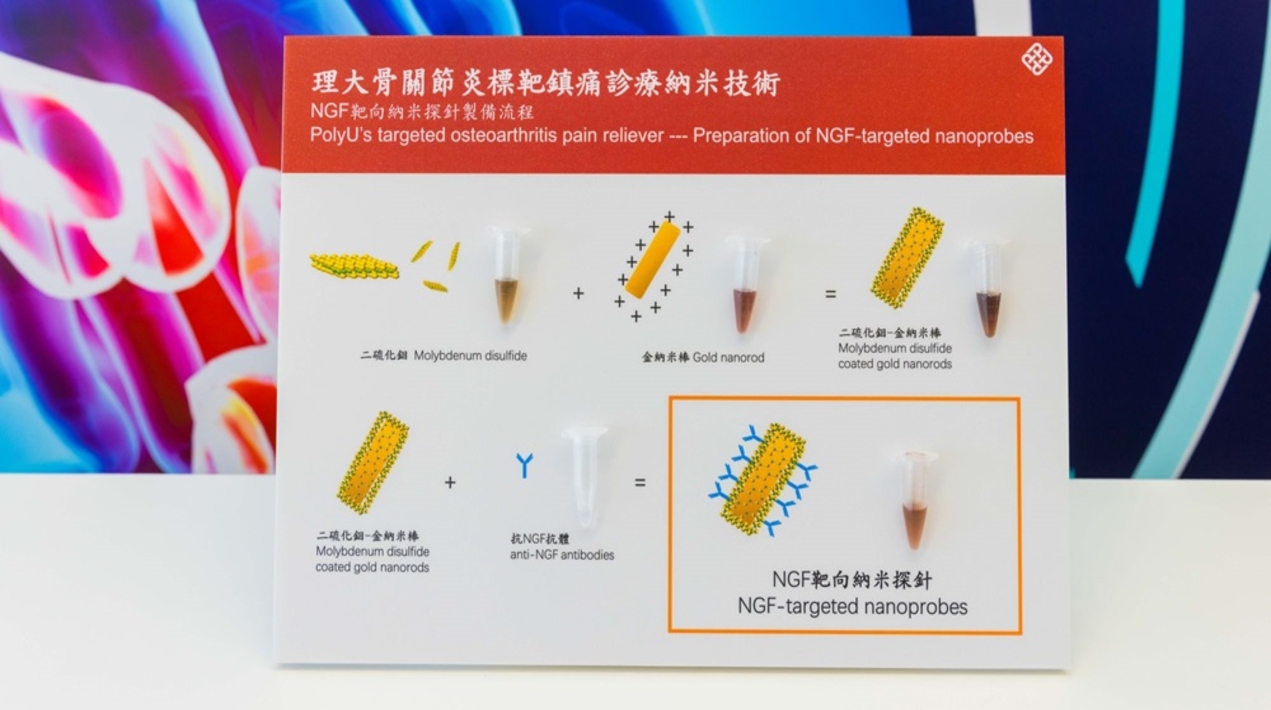
Researchers at The Hong Kong Polytechnic University (PolyU) have developed a ground-breaking, imaging-guided nanoparticle photothermal treatment for osteoarthritis pain, utilising the concept of targeted cancer therapy but instead applied to the protein that initiates pain signalling along the nervous system.
The novel targeted osteoarthritis pain theranostics, which offer both diagnostics and therapeutics, are made of gold nanorods coated with a two-dimensional nanomaterial, molybdenum disulfide. The coated nanorods are further fused with antibodies directed against the nerve growth factor (NGF), the pain-triggering protein.
The antibody-fused nanorods enable both active and passive targeting on peripheral osteoarthritis pain generation. In addition, by directly binding NGF molecules to the photothermal nanoparticles, which can transfer light energy to local heat, the NGF protein will be destroyed under heating with a near-infrared laser.
Professor Yang Mo, Associate Head (Research) of the Department of Biomedical Engineering and a principal investigator of the study, said testing on mice suggests the targeted photothermal treatment achieves satisfactory pain relief and improvement of motor function. He noted that this is the first time the concept of targeted photothermal therapy for osteoarthritis pain via nanotechnology is being introduced. Nanoparticles hold good promise for clinical translation to achieve long-lasting pain relief for days, compared to currently available medications that can only alleviate pain for hours. In their experiment with the mouse models of osteoarthritis, the nanorods with laser stimulation reduced signs of pain for three to four days.
Another principal investigator, Dr Wen Chunyi, Associate Professor from the Department of Biomedical Engineering, said the dual-track pain treatments with the antibody-fused nanorods and laser stimulation reduced the amount of NGF in joint tissues more efficiently and did not cause damage to the surrounding soft tissues or bone.
A major concern of previous anti-NGF therapy in clinical trials is the development of destructive arthropathy after using high doses of anti-NGF antibodies. To address this issue, the team developed the targeted theranostic approach to locate and remove NGF so that a minimal dosage of anti-NGF antibodies is required, Dr Wen explained, adding that only around 1/100 of the therapeutic dosage used in previous clinical trials for control of osteoarthritis pain is needed under the new approach.
Osteoarthritis is currently diagnosed by physical examination and, where necessary, with x-ray, MRI scanning and arthroscopy. PolyU’s novel technology enables a new and accurate diagnostics approach – osteoarthritis pain imaging, as the nanorods localised to the injured joints can be tracked using photoacoustic imaging – a new non-invasive imaging modality that combines high contrast and good specificity of optical imaging, while delivering the high resolution and penetration depth offered by ultrasound imaging.
The research team chose gold nanorods due to their good photothermal properties and molybdenum disulfide coating due to its good biocompatibility. Moreover, molybdenum disulfide has good thermal conductivity and water solubility, as well as high near-infrared absorbance, making it a superior contrast agent for photoacoustic imaging that improves the nanorods’ photothermal properties.
The Lancet Commission on osteoarthritis estimated the illness has affected more than 500 million people worldwide. The World Health Organization also expects the prevalence of osteoarthritis to increase due to population ageing and a rise in related factors such as obesity.
Treatment of osteoarthritis focuses on decreasing pain and improving joint movement. However, painkillers are currently non-targeted and some even involve significant side effects. Meanwhile, total knee replacement is costly and requires considerable waiting time for surgery at public hospitals.
The team’s molecular theranostics technology, if it becomes clinically available, could bring the prospect of deferring the need for expensive joint replacement operations for years and greatly improve the quality of life of osteoarthritis patients, Dr Wen added.
The research findings have been published in the prestigious journal ACS Nano by the American Chemical Society and were reported by Nature Reviews Rheumatology.
















